McDonald's Global Marketing Strategy: A Strategic Management Report
VerifiedAdded on 2019/12/03
|15
|4280
|159
Report
AI Summary
This report provides a detailed strategic analysis of McDonald's marketing strategies in the global marketplace. It begins with an introduction to strategic management and the case study approach, focusing on how McDonald's achieves a competitive edge. The report includes a company background, highlighting McDonald's global presence and product offerings. The main analysis examines the company's use of both standardization and localization approaches, supported by the marketing mix model. SWOT, PESTEL, and Porter's Five Forces analyses are applied to evaluate McDonald's internal and external environments. The SWOT analysis identifies strengths, weaknesses, opportunities, and threats, while PESTEL assesses political, economic, social, technological, environmental, and legal factors. The Porter's Five Forces model evaluates the competitive forces within the fast-food industry. The report concludes with recommendations and a summary of the findings, emphasizing how McDonald's adapts its marketing strategies to succeed in diverse markets.
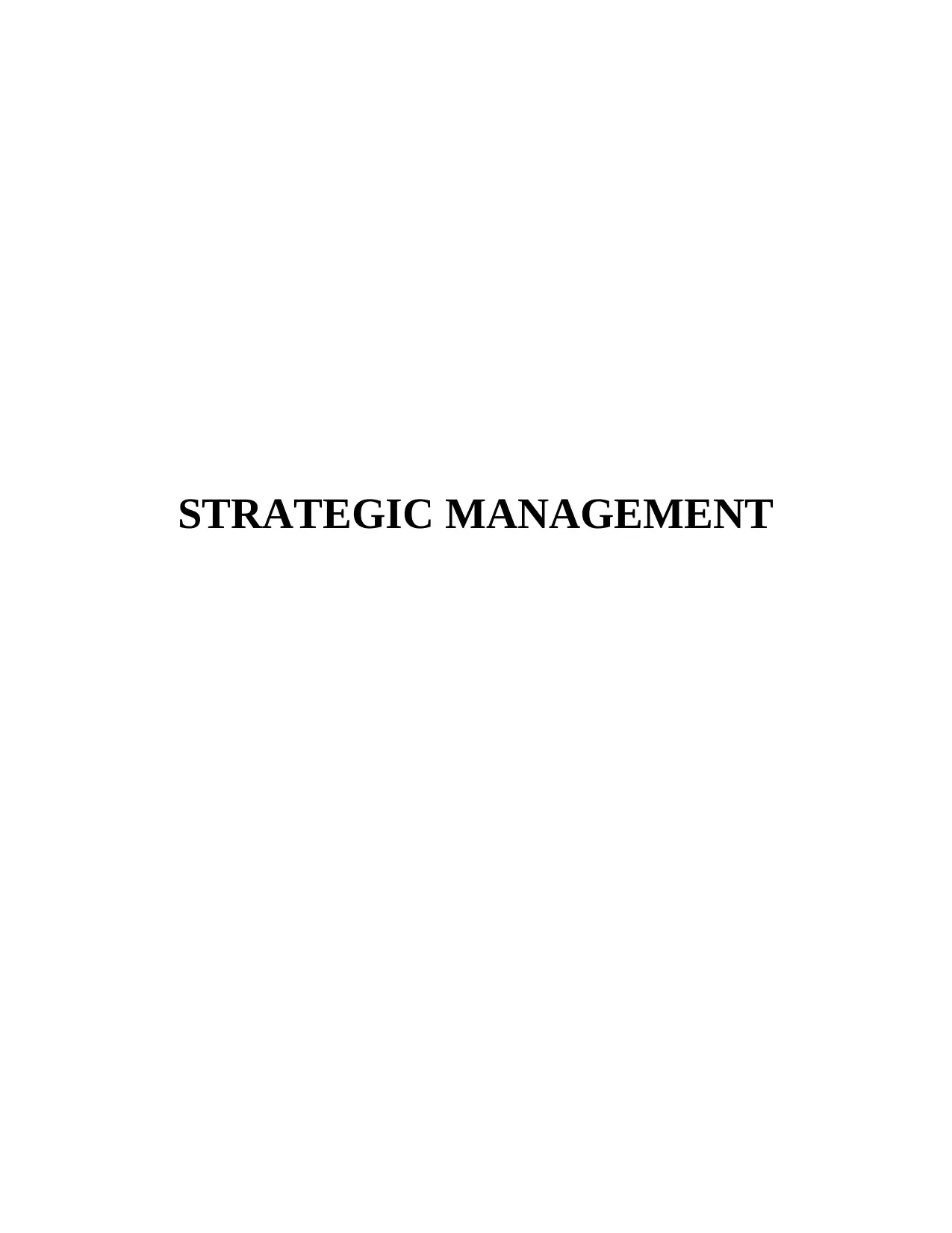
STRATEGIC MANAGEMENT
Paraphrase This Document
Need a fresh take? Get an instant paraphrase of this document with our AI Paraphraser
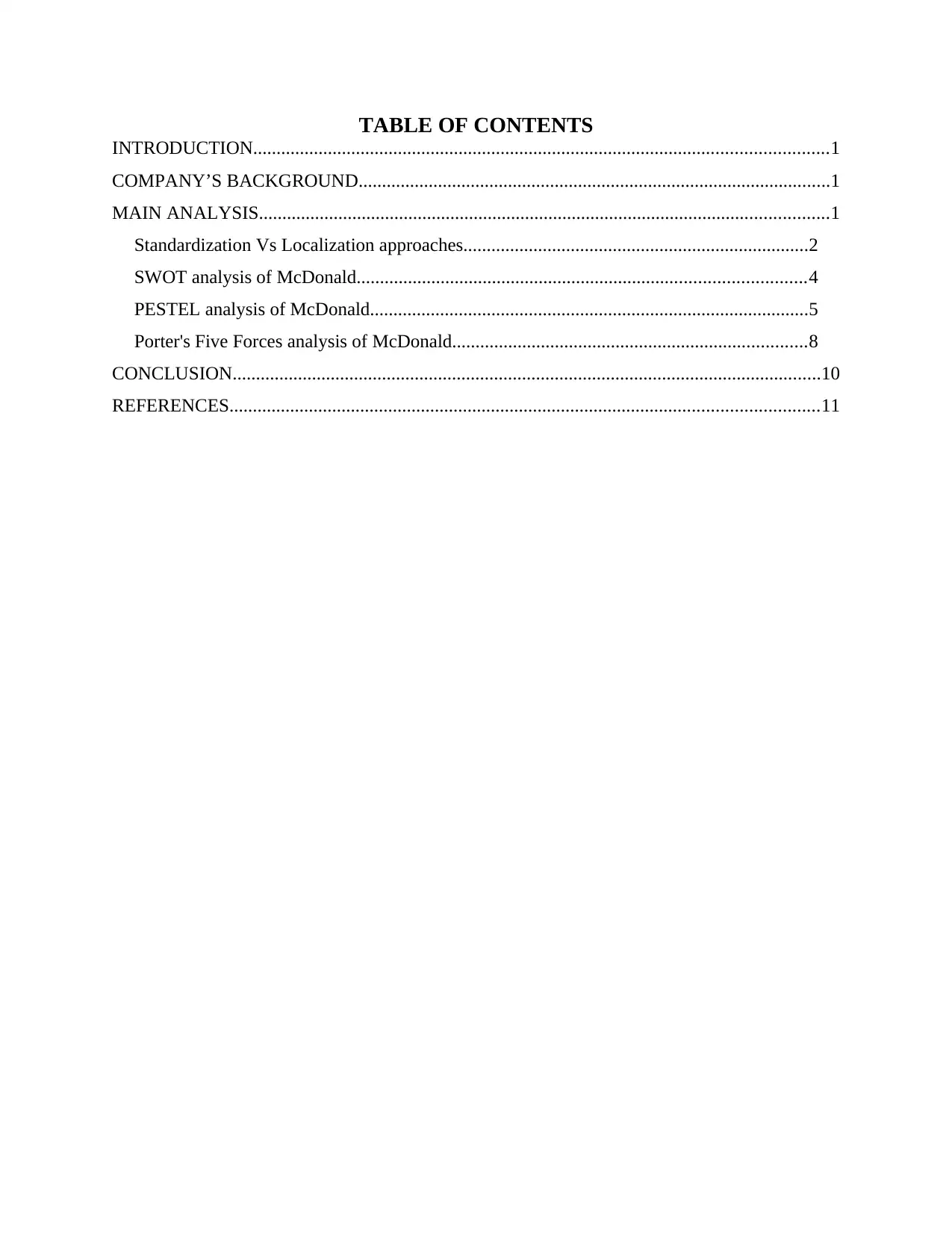
TABLE OF CONTENTS
INTRODUCTION...........................................................................................................................1
COMPANY’S BACKGROUND.....................................................................................................1
MAIN ANALYSIS..........................................................................................................................1
Standardization Vs Localization approaches..........................................................................2
SWOT analysis of McDonald................................................................................................4
PESTEL analysis of McDonald..............................................................................................5
Porter's Five Forces analysis of McDonald............................................................................8
CONCLUSION..............................................................................................................................10
REFERENCES..............................................................................................................................11
INTRODUCTION...........................................................................................................................1
COMPANY’S BACKGROUND.....................................................................................................1
MAIN ANALYSIS..........................................................................................................................1
Standardization Vs Localization approaches..........................................................................2
SWOT analysis of McDonald................................................................................................4
PESTEL analysis of McDonald..............................................................................................5
Porter's Five Forces analysis of McDonald............................................................................8
CONCLUSION..............................................................................................................................10
REFERENCES..............................................................................................................................11
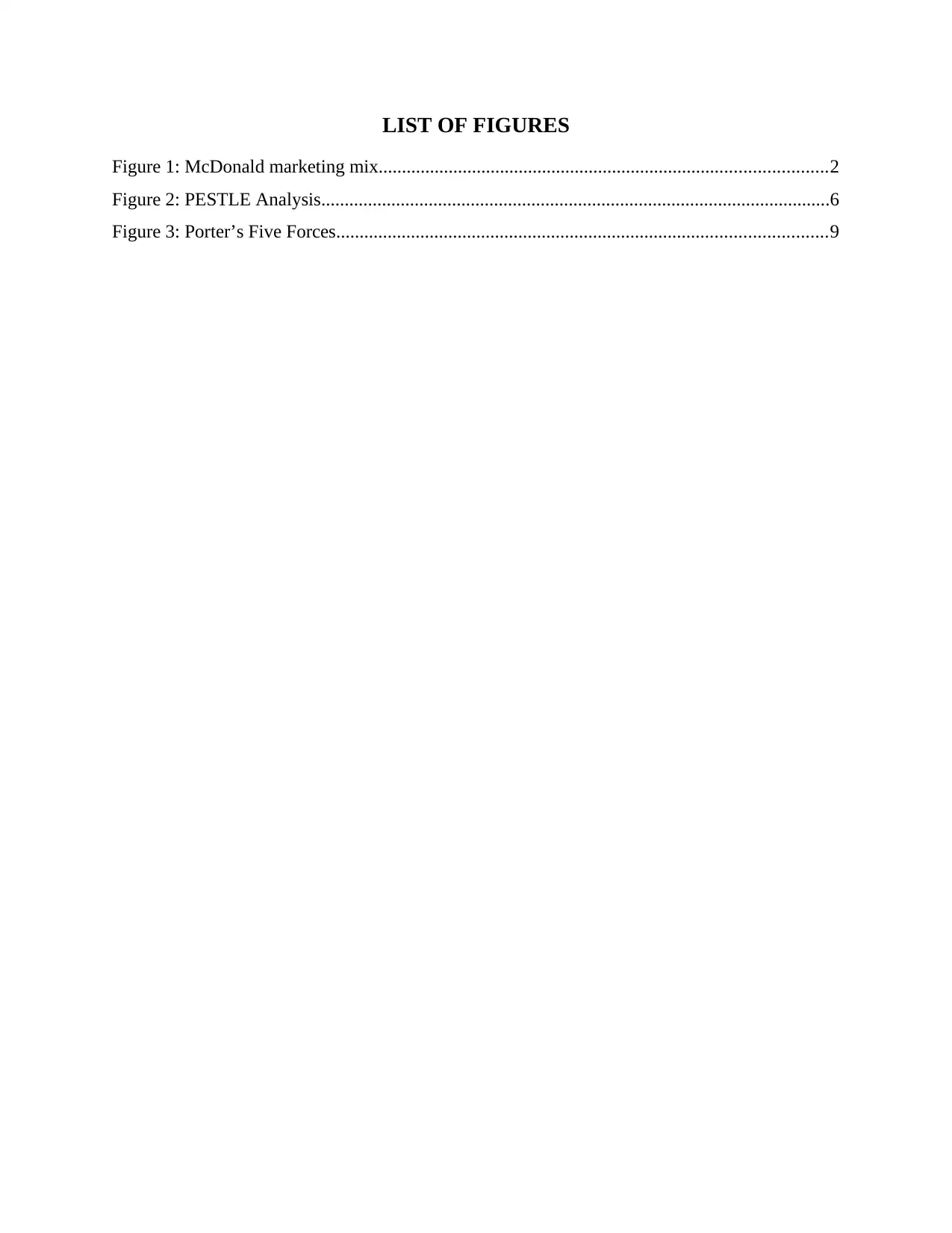
LIST OF FIGURES
Figure 1: McDonald marketing mix................................................................................................2
Figure 2: PESTLE Analysis.............................................................................................................6
Figure 3: Porter’s Five Forces.........................................................................................................9
Figure 1: McDonald marketing mix................................................................................................2
Figure 2: PESTLE Analysis.............................................................................................................6
Figure 3: Porter’s Five Forces.........................................................................................................9
⊘ This is a preview!⊘
Do you want full access?
Subscribe today to unlock all pages.

Trusted by 1+ million students worldwide
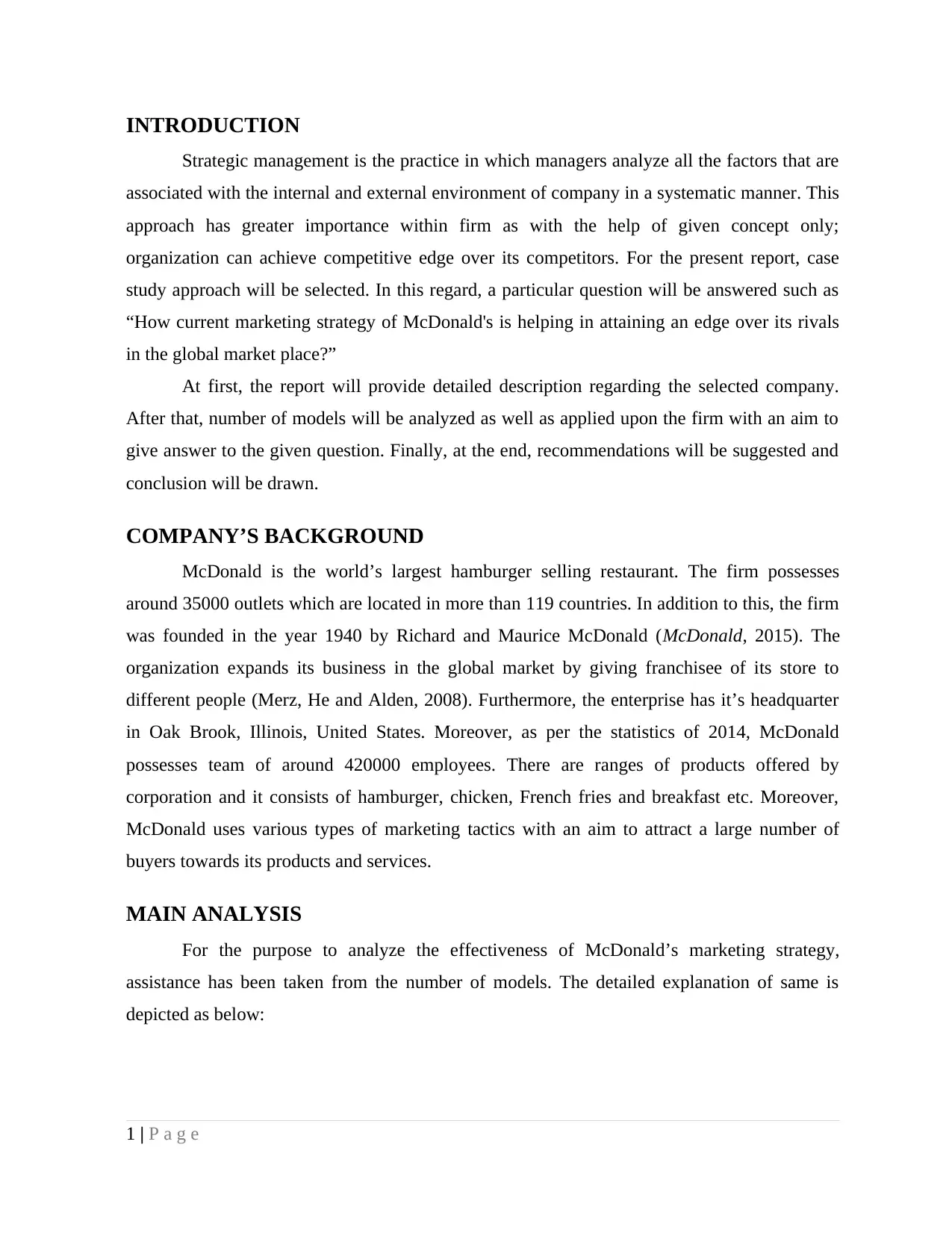
INTRODUCTION
Strategic management is the practice in which managers analyze all the factors that are
associated with the internal and external environment of company in a systematic manner. This
approach has greater importance within firm as with the help of given concept only;
organization can achieve competitive edge over its competitors. For the present report, case
study approach will be selected. In this regard, a particular question will be answered such as
“How current marketing strategy of McDonald's is helping in attaining an edge over its rivals
in the global market place?”
At first, the report will provide detailed description regarding the selected company.
After that, number of models will be analyzed as well as applied upon the firm with an aim to
give answer to the given question. Finally, at the end, recommendations will be suggested and
conclusion will be drawn.
COMPANY’S BACKGROUND
McDonald is the world’s largest hamburger selling restaurant. The firm possesses
around 35000 outlets which are located in more than 119 countries. In addition to this, the firm
was founded in the year 1940 by Richard and Maurice McDonald (McDonald, 2015). The
organization expands its business in the global market by giving franchisee of its store to
different people (Merz, He and Alden, 2008). Furthermore, the enterprise has it’s headquarter
in Oak Brook, Illinois, United States. Moreover, as per the statistics of 2014, McDonald
possesses team of around 420000 employees. There are ranges of products offered by
corporation and it consists of hamburger, chicken, French fries and breakfast etc. Moreover,
McDonald uses various types of marketing tactics with an aim to attract a large number of
buyers towards its products and services.
MAIN ANALYSIS
For the purpose to analyze the effectiveness of McDonald’s marketing strategy,
assistance has been taken from the number of models. The detailed explanation of same is
depicted as below:
1 | P a g e
Strategic management is the practice in which managers analyze all the factors that are
associated with the internal and external environment of company in a systematic manner. This
approach has greater importance within firm as with the help of given concept only;
organization can achieve competitive edge over its competitors. For the present report, case
study approach will be selected. In this regard, a particular question will be answered such as
“How current marketing strategy of McDonald's is helping in attaining an edge over its rivals
in the global market place?”
At first, the report will provide detailed description regarding the selected company.
After that, number of models will be analyzed as well as applied upon the firm with an aim to
give answer to the given question. Finally, at the end, recommendations will be suggested and
conclusion will be drawn.
COMPANY’S BACKGROUND
McDonald is the world’s largest hamburger selling restaurant. The firm possesses
around 35000 outlets which are located in more than 119 countries. In addition to this, the firm
was founded in the year 1940 by Richard and Maurice McDonald (McDonald, 2015). The
organization expands its business in the global market by giving franchisee of its store to
different people (Merz, He and Alden, 2008). Furthermore, the enterprise has it’s headquarter
in Oak Brook, Illinois, United States. Moreover, as per the statistics of 2014, McDonald
possesses team of around 420000 employees. There are ranges of products offered by
corporation and it consists of hamburger, chicken, French fries and breakfast etc. Moreover,
McDonald uses various types of marketing tactics with an aim to attract a large number of
buyers towards its products and services.
MAIN ANALYSIS
For the purpose to analyze the effectiveness of McDonald’s marketing strategy,
assistance has been taken from the number of models. The detailed explanation of same is
depicted as below:
1 | P a g e
Paraphrase This Document
Need a fresh take? Get an instant paraphrase of this document with our AI Paraphraser
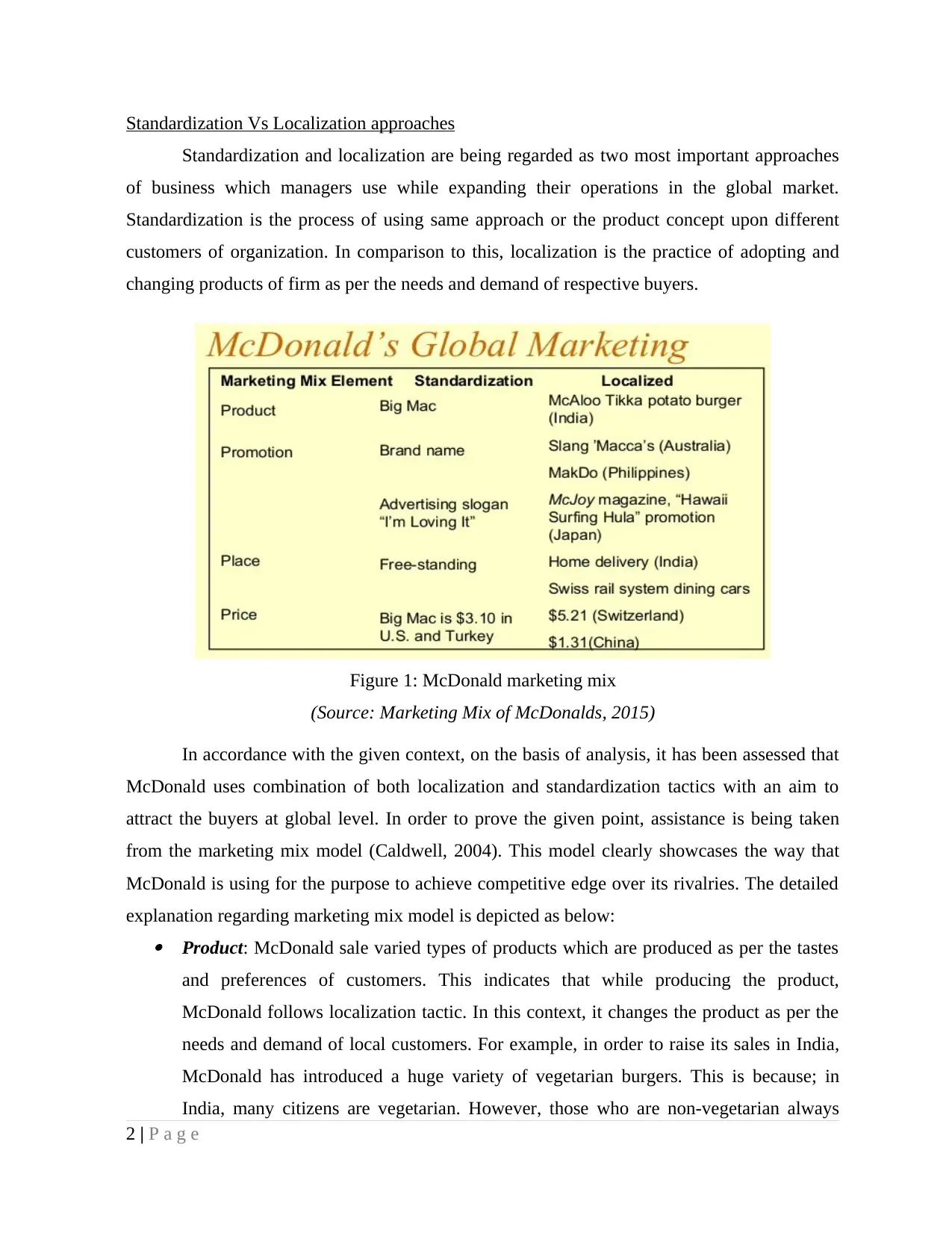
Standardization Vs Localization approaches
Standardization and localization are being regarded as two most important approaches
of business which managers use while expanding their operations in the global market.
Standardization is the process of using same approach or the product concept upon different
customers of organization. In comparison to this, localization is the practice of adopting and
changing products of firm as per the needs and demand of respective buyers.
Figure 1: McDonald marketing mix
(Source: Marketing Mix of McDonalds, 2015)
In accordance with the given context, on the basis of analysis, it has been assessed that
McDonald uses combination of both localization and standardization tactics with an aim to
attract the buyers at global level. In order to prove the given point, assistance is being taken
from the marketing mix model (Caldwell, 2004). This model clearly showcases the way that
McDonald is using for the purpose to achieve competitive edge over its rivalries. The detailed
explanation regarding marketing mix model is depicted as below: Product: McDonald sale varied types of products which are produced as per the tastes
and preferences of customers. This indicates that while producing the product,
McDonald follows localization tactic. In this context, it changes the product as per the
needs and demand of local customers. For example, in order to raise its sales in India,
McDonald has introduced a huge variety of vegetarian burgers. This is because; in
India, many citizens are vegetarian. However, those who are non-vegetarian always
2 | P a g e
Standardization and localization are being regarded as two most important approaches
of business which managers use while expanding their operations in the global market.
Standardization is the process of using same approach or the product concept upon different
customers of organization. In comparison to this, localization is the practice of adopting and
changing products of firm as per the needs and demand of respective buyers.
Figure 1: McDonald marketing mix
(Source: Marketing Mix of McDonalds, 2015)
In accordance with the given context, on the basis of analysis, it has been assessed that
McDonald uses combination of both localization and standardization tactics with an aim to
attract the buyers at global level. In order to prove the given point, assistance is being taken
from the marketing mix model (Caldwell, 2004). This model clearly showcases the way that
McDonald is using for the purpose to achieve competitive edge over its rivalries. The detailed
explanation regarding marketing mix model is depicted as below: Product: McDonald sale varied types of products which are produced as per the tastes
and preferences of customers. This indicates that while producing the product,
McDonald follows localization tactic. In this context, it changes the product as per the
needs and demand of local customers. For example, in order to raise its sales in India,
McDonald has introduced a huge variety of vegetarian burgers. This is because; in
India, many citizens are vegetarian. However, those who are non-vegetarian always
2 | P a g e
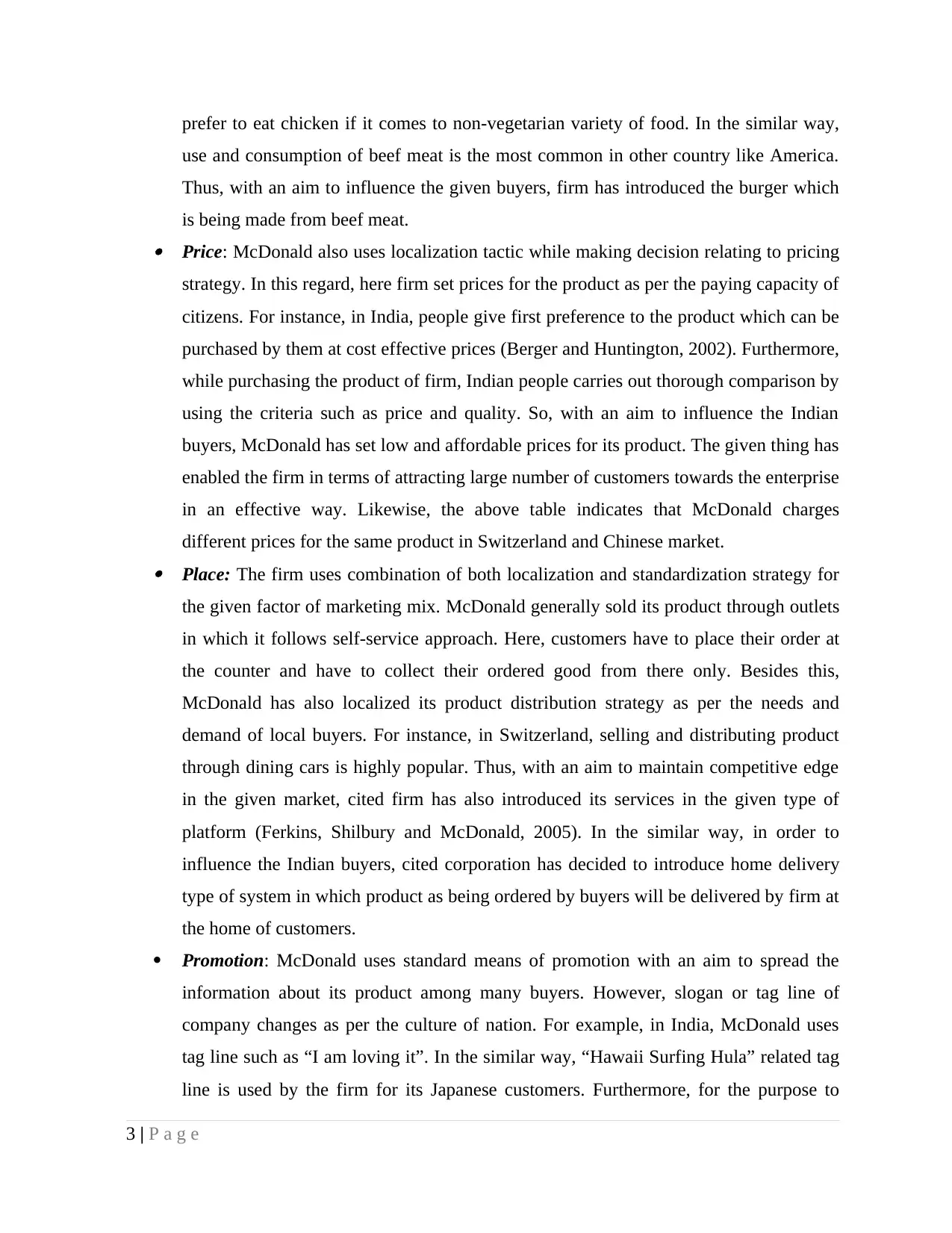
prefer to eat chicken if it comes to non-vegetarian variety of food. In the similar way,
use and consumption of beef meat is the most common in other country like America.
Thus, with an aim to influence the given buyers, firm has introduced the burger which
is being made from beef meat. Price: McDonald also uses localization tactic while making decision relating to pricing
strategy. In this regard, here firm set prices for the product as per the paying capacity of
citizens. For instance, in India, people give first preference to the product which can be
purchased by them at cost effective prices (Berger and Huntington, 2002). Furthermore,
while purchasing the product of firm, Indian people carries out thorough comparison by
using the criteria such as price and quality. So, with an aim to influence the Indian
buyers, McDonald has set low and affordable prices for its product. The given thing has
enabled the firm in terms of attracting large number of customers towards the enterprise
in an effective way. Likewise, the above table indicates that McDonald charges
different prices for the same product in Switzerland and Chinese market. Place: The firm uses combination of both localization and standardization strategy for
the given factor of marketing mix. McDonald generally sold its product through outlets
in which it follows self-service approach. Here, customers have to place their order at
the counter and have to collect their ordered good from there only. Besides this,
McDonald has also localized its product distribution strategy as per the needs and
demand of local buyers. For instance, in Switzerland, selling and distributing product
through dining cars is highly popular. Thus, with an aim to maintain competitive edge
in the given market, cited firm has also introduced its services in the given type of
platform (Ferkins, Shilbury and McDonald, 2005). In the similar way, in order to
influence the Indian buyers, cited corporation has decided to introduce home delivery
type of system in which product as being ordered by buyers will be delivered by firm at
the home of customers.
Promotion: McDonald uses standard means of promotion with an aim to spread the
information about its product among many buyers. However, slogan or tag line of
company changes as per the culture of nation. For example, in India, McDonald uses
tag line such as “I am loving it”. In the similar way, “Hawaii Surfing Hula” related tag
line is used by the firm for its Japanese customers. Furthermore, for the purpose to
3 | P a g e
use and consumption of beef meat is the most common in other country like America.
Thus, with an aim to influence the given buyers, firm has introduced the burger which
is being made from beef meat. Price: McDonald also uses localization tactic while making decision relating to pricing
strategy. In this regard, here firm set prices for the product as per the paying capacity of
citizens. For instance, in India, people give first preference to the product which can be
purchased by them at cost effective prices (Berger and Huntington, 2002). Furthermore,
while purchasing the product of firm, Indian people carries out thorough comparison by
using the criteria such as price and quality. So, with an aim to influence the Indian
buyers, McDonald has set low and affordable prices for its product. The given thing has
enabled the firm in terms of attracting large number of customers towards the enterprise
in an effective way. Likewise, the above table indicates that McDonald charges
different prices for the same product in Switzerland and Chinese market. Place: The firm uses combination of both localization and standardization strategy for
the given factor of marketing mix. McDonald generally sold its product through outlets
in which it follows self-service approach. Here, customers have to place their order at
the counter and have to collect their ordered good from there only. Besides this,
McDonald has also localized its product distribution strategy as per the needs and
demand of local buyers. For instance, in Switzerland, selling and distributing product
through dining cars is highly popular. Thus, with an aim to maintain competitive edge
in the given market, cited firm has also introduced its services in the given type of
platform (Ferkins, Shilbury and McDonald, 2005). In the similar way, in order to
influence the Indian buyers, cited corporation has decided to introduce home delivery
type of system in which product as being ordered by buyers will be delivered by firm at
the home of customers.
Promotion: McDonald uses standard means of promotion with an aim to spread the
information about its product among many buyers. However, slogan or tag line of
company changes as per the culture of nation. For example, in India, McDonald uses
tag line such as “I am loving it”. In the similar way, “Hawaii Surfing Hula” related tag
line is used by the firm for its Japanese customers. Furthermore, for the purpose to
3 | P a g e
⊘ This is a preview!⊘
Do you want full access?
Subscribe today to unlock all pages.

Trusted by 1+ million students worldwide
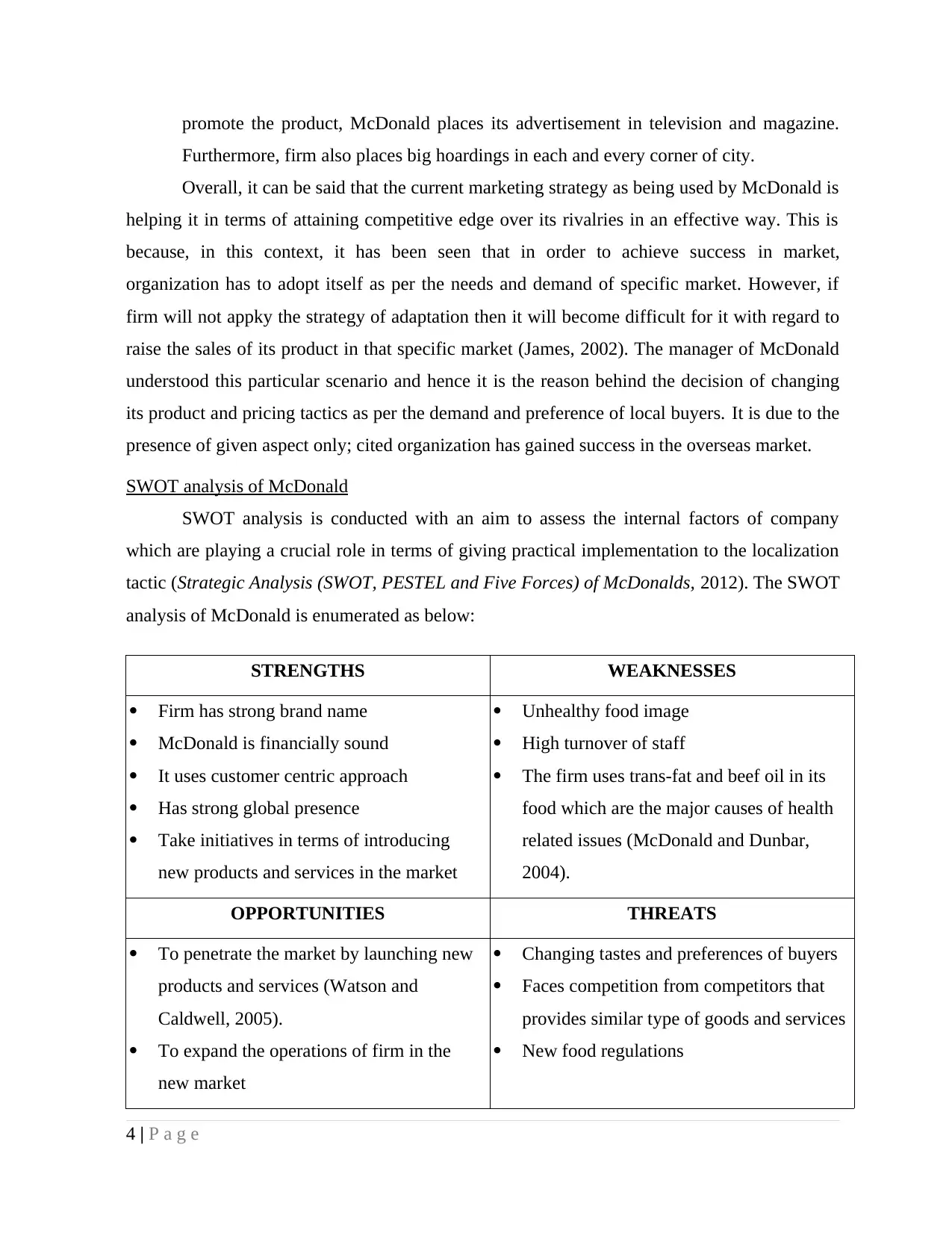
promote the product, McDonald places its advertisement in television and magazine.
Furthermore, firm also places big hoardings in each and every corner of city.
Overall, it can be said that the current marketing strategy as being used by McDonald is
helping it in terms of attaining competitive edge over its rivalries in an effective way. This is
because, in this context, it has been seen that in order to achieve success in market,
organization has to adopt itself as per the needs and demand of specific market. However, if
firm will not appky the strategy of adaptation then it will become difficult for it with regard to
raise the sales of its product in that specific market (James, 2002). The manager of McDonald
understood this particular scenario and hence it is the reason behind the decision of changing
its product and pricing tactics as per the demand and preference of local buyers. It is due to the
presence of given aspect only; cited organization has gained success in the overseas market.
SWOT analysis of McDonald
SWOT analysis is conducted with an aim to assess the internal factors of company
which are playing a crucial role in terms of giving practical implementation to the localization
tactic (Strategic Analysis (SWOT, PESTEL and Five Forces) of McDonalds, 2012). The SWOT
analysis of McDonald is enumerated as below:
STRENGTHS WEAKNESSES
Firm has strong brand name
McDonald is financially sound
It uses customer centric approach
Has strong global presence
Take initiatives in terms of introducing
new products and services in the market
Unhealthy food image
High turnover of staff
The firm uses trans-fat and beef oil in its
food which are the major causes of health
related issues (McDonald and Dunbar,
2004).
OPPORTUNITIES THREATS
To penetrate the market by launching new
products and services (Watson and
Caldwell, 2005).
To expand the operations of firm in the
new market
Changing tastes and preferences of buyers
Faces competition from competitors that
provides similar type of goods and services
New food regulations
4 | P a g e
Furthermore, firm also places big hoardings in each and every corner of city.
Overall, it can be said that the current marketing strategy as being used by McDonald is
helping it in terms of attaining competitive edge over its rivalries in an effective way. This is
because, in this context, it has been seen that in order to achieve success in market,
organization has to adopt itself as per the needs and demand of specific market. However, if
firm will not appky the strategy of adaptation then it will become difficult for it with regard to
raise the sales of its product in that specific market (James, 2002). The manager of McDonald
understood this particular scenario and hence it is the reason behind the decision of changing
its product and pricing tactics as per the demand and preference of local buyers. It is due to the
presence of given aspect only; cited organization has gained success in the overseas market.
SWOT analysis of McDonald
SWOT analysis is conducted with an aim to assess the internal factors of company
which are playing a crucial role in terms of giving practical implementation to the localization
tactic (Strategic Analysis (SWOT, PESTEL and Five Forces) of McDonalds, 2012). The SWOT
analysis of McDonald is enumerated as below:
STRENGTHS WEAKNESSES
Firm has strong brand name
McDonald is financially sound
It uses customer centric approach
Has strong global presence
Take initiatives in terms of introducing
new products and services in the market
Unhealthy food image
High turnover of staff
The firm uses trans-fat and beef oil in its
food which are the major causes of health
related issues (McDonald and Dunbar,
2004).
OPPORTUNITIES THREATS
To penetrate the market by launching new
products and services (Watson and
Caldwell, 2005).
To expand the operations of firm in the
new market
Changing tastes and preferences of buyers
Faces competition from competitors that
provides similar type of goods and services
New food regulations
4 | P a g e
Paraphrase This Document
Need a fresh take? Get an instant paraphrase of this document with our AI Paraphraser
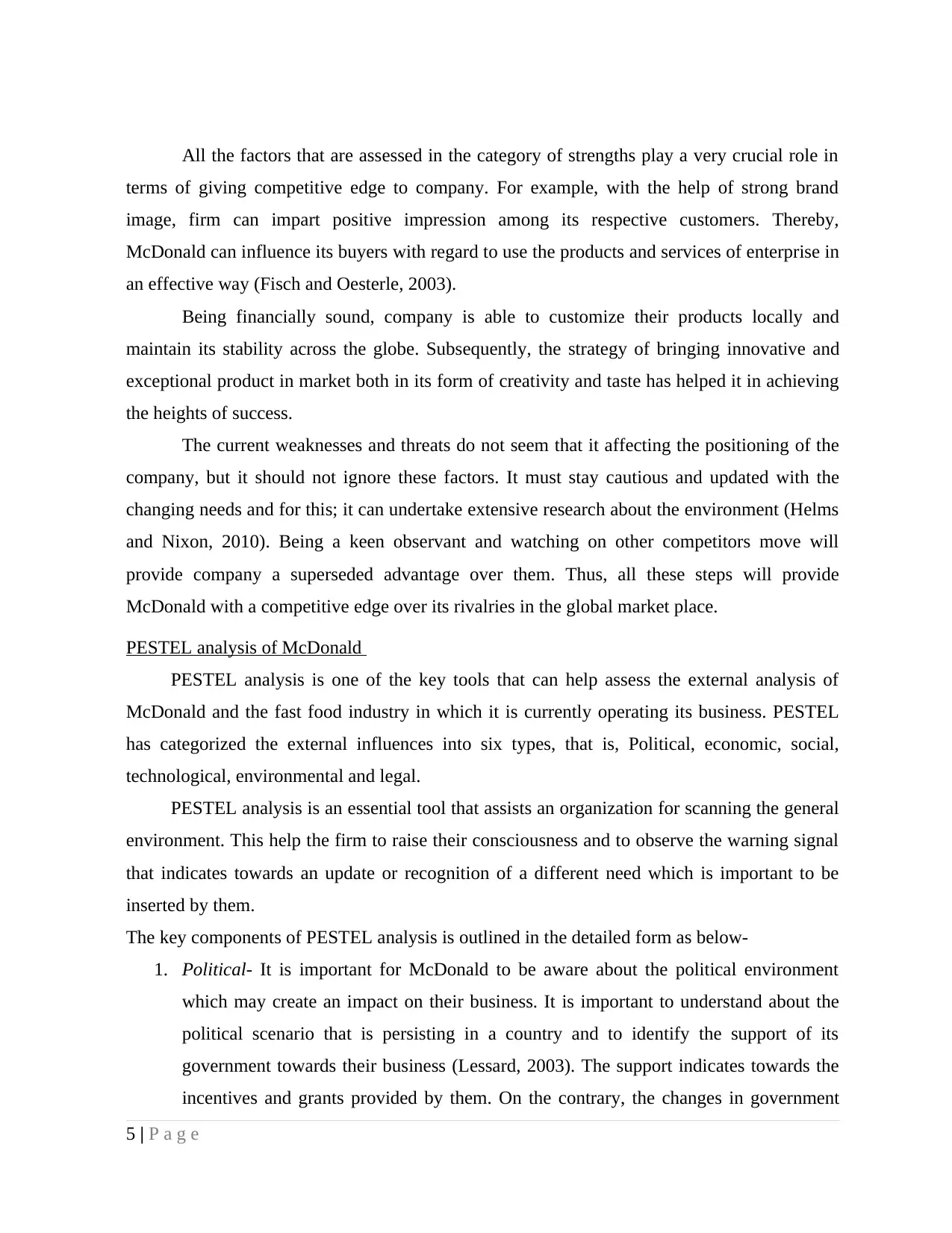
All the factors that are assessed in the category of strengths play a very crucial role in
terms of giving competitive edge to company. For example, with the help of strong brand
image, firm can impart positive impression among its respective customers. Thereby,
McDonald can influence its buyers with regard to use the products and services of enterprise in
an effective way (Fisch and Oesterle, 2003).
Being financially sound, company is able to customize their products locally and
maintain its stability across the globe. Subsequently, the strategy of bringing innovative and
exceptional product in market both in its form of creativity and taste has helped it in achieving
the heights of success.
The current weaknesses and threats do not seem that it affecting the positioning of the
company, but it should not ignore these factors. It must stay cautious and updated with the
changing needs and for this; it can undertake extensive research about the environment (Helms
and Nixon, 2010). Being a keen observant and watching on other competitors move will
provide company a superseded advantage over them. Thus, all these steps will provide
McDonald with a competitive edge over its rivalries in the global market place.
PESTEL analysis of McDonald
PESTEL analysis is one of the key tools that can help assess the external analysis of
McDonald and the fast food industry in which it is currently operating its business. PESTEL
has categorized the external influences into six types, that is, Political, economic, social,
technological, environmental and legal.
PESTEL analysis is an essential tool that assists an organization for scanning the general
environment. This help the firm to raise their consciousness and to observe the warning signal
that indicates towards an update or recognition of a different need which is important to be
inserted by them.
The key components of PESTEL analysis is outlined in the detailed form as below-
1. Political- It is important for McDonald to be aware about the political environment
which may create an impact on their business. It is important to understand about the
political scenario that is persisting in a country and to identify the support of its
government towards their business (Lessard, 2003). The support indicates towards the
incentives and grants provided by them. On the contrary, the changes in government
5 | P a g e
terms of giving competitive edge to company. For example, with the help of strong brand
image, firm can impart positive impression among its respective customers. Thereby,
McDonald can influence its buyers with regard to use the products and services of enterprise in
an effective way (Fisch and Oesterle, 2003).
Being financially sound, company is able to customize their products locally and
maintain its stability across the globe. Subsequently, the strategy of bringing innovative and
exceptional product in market both in its form of creativity and taste has helped it in achieving
the heights of success.
The current weaknesses and threats do not seem that it affecting the positioning of the
company, but it should not ignore these factors. It must stay cautious and updated with the
changing needs and for this; it can undertake extensive research about the environment (Helms
and Nixon, 2010). Being a keen observant and watching on other competitors move will
provide company a superseded advantage over them. Thus, all these steps will provide
McDonald with a competitive edge over its rivalries in the global market place.
PESTEL analysis of McDonald
PESTEL analysis is one of the key tools that can help assess the external analysis of
McDonald and the fast food industry in which it is currently operating its business. PESTEL
has categorized the external influences into six types, that is, Political, economic, social,
technological, environmental and legal.
PESTEL analysis is an essential tool that assists an organization for scanning the general
environment. This help the firm to raise their consciousness and to observe the warning signal
that indicates towards an update or recognition of a different need which is important to be
inserted by them.
The key components of PESTEL analysis is outlined in the detailed form as below-
1. Political- It is important for McDonald to be aware about the political environment
which may create an impact on their business. It is important to understand about the
political scenario that is persisting in a country and to identify the support of its
government towards their business (Lessard, 2003). The support indicates towards the
incentives and grants provided by them. On the contrary, the changes in government
5 | P a g e
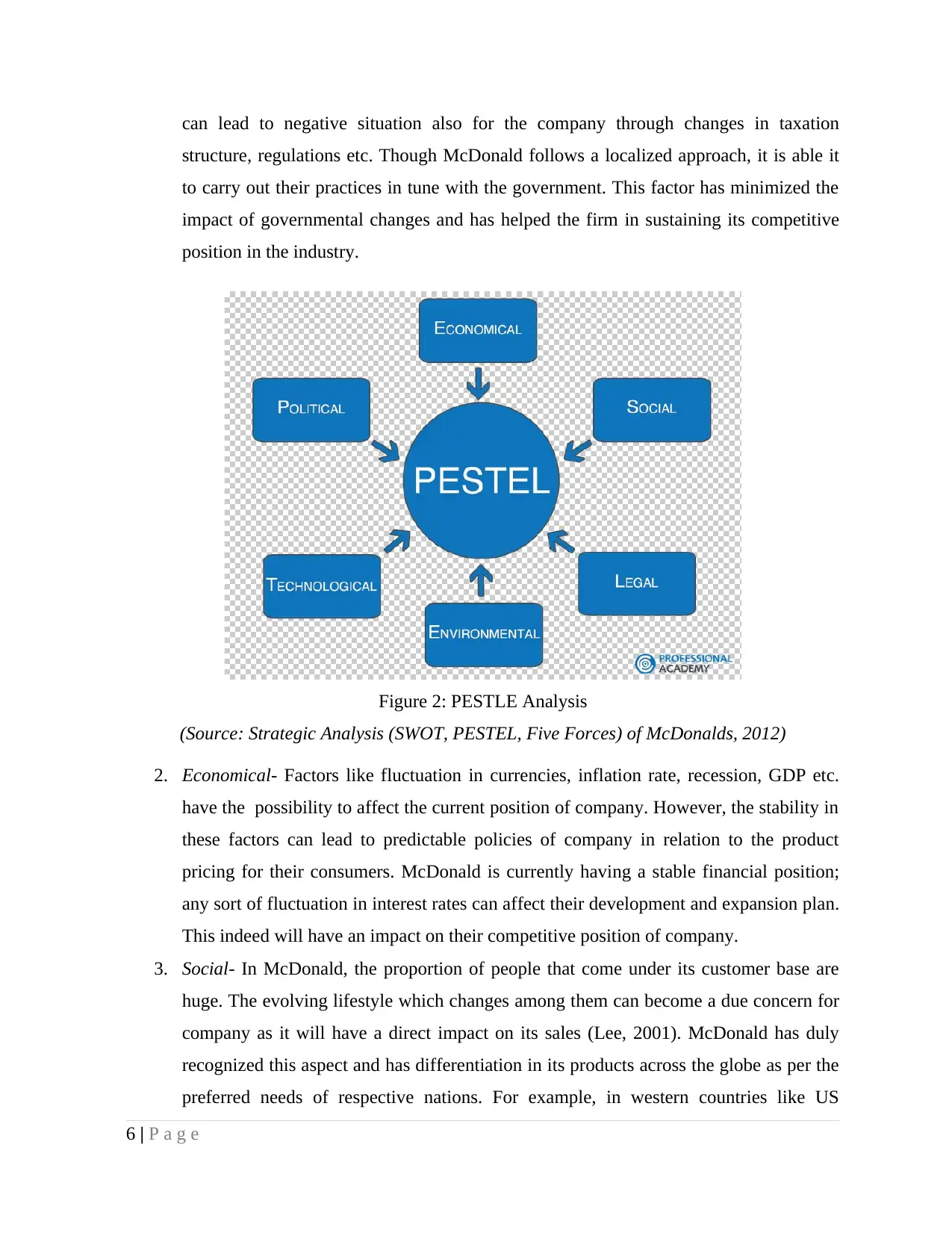
can lead to negative situation also for the company through changes in taxation
structure, regulations etc. Though McDonald follows a localized approach, it is able it
to carry out their practices in tune with the government. This factor has minimized the
impact of governmental changes and has helped the firm in sustaining its competitive
position in the industry.
Figure 2: PESTLE Analysis
(Source: Strategic Analysis (SWOT, PESTEL, Five Forces) of McDonalds, 2012)
2. Economical- Factors like fluctuation in currencies, inflation rate, recession, GDP etc.
have the possibility to affect the current position of company. However, the stability in
these factors can lead to predictable policies of company in relation to the product
pricing for their consumers. McDonald is currently having a stable financial position;
any sort of fluctuation in interest rates can affect their development and expansion plan.
This indeed will have an impact on their competitive position of company.
3. Social- In McDonald, the proportion of people that come under its customer base are
huge. The evolving lifestyle which changes among them can become a due concern for
company as it will have a direct impact on its sales (Lee, 2001). McDonald has duly
recognized this aspect and has differentiation in its products across the globe as per the
preferred needs of respective nations. For example, in western countries like US
6 | P a g e
structure, regulations etc. Though McDonald follows a localized approach, it is able it
to carry out their practices in tune with the government. This factor has minimized the
impact of governmental changes and has helped the firm in sustaining its competitive
position in the industry.
Figure 2: PESTLE Analysis
(Source: Strategic Analysis (SWOT, PESTEL, Five Forces) of McDonalds, 2012)
2. Economical- Factors like fluctuation in currencies, inflation rate, recession, GDP etc.
have the possibility to affect the current position of company. However, the stability in
these factors can lead to predictable policies of company in relation to the product
pricing for their consumers. McDonald is currently having a stable financial position;
any sort of fluctuation in interest rates can affect their development and expansion plan.
This indeed will have an impact on their competitive position of company.
3. Social- In McDonald, the proportion of people that come under its customer base are
huge. The evolving lifestyle which changes among them can become a due concern for
company as it will have a direct impact on its sales (Lee, 2001). McDonald has duly
recognized this aspect and has differentiation in its products across the globe as per the
preferred needs of respective nations. For example, in western countries like US
6 | P a g e
⊘ This is a preview!⊘
Do you want full access?
Subscribe today to unlock all pages.

Trusted by 1+ million students worldwide
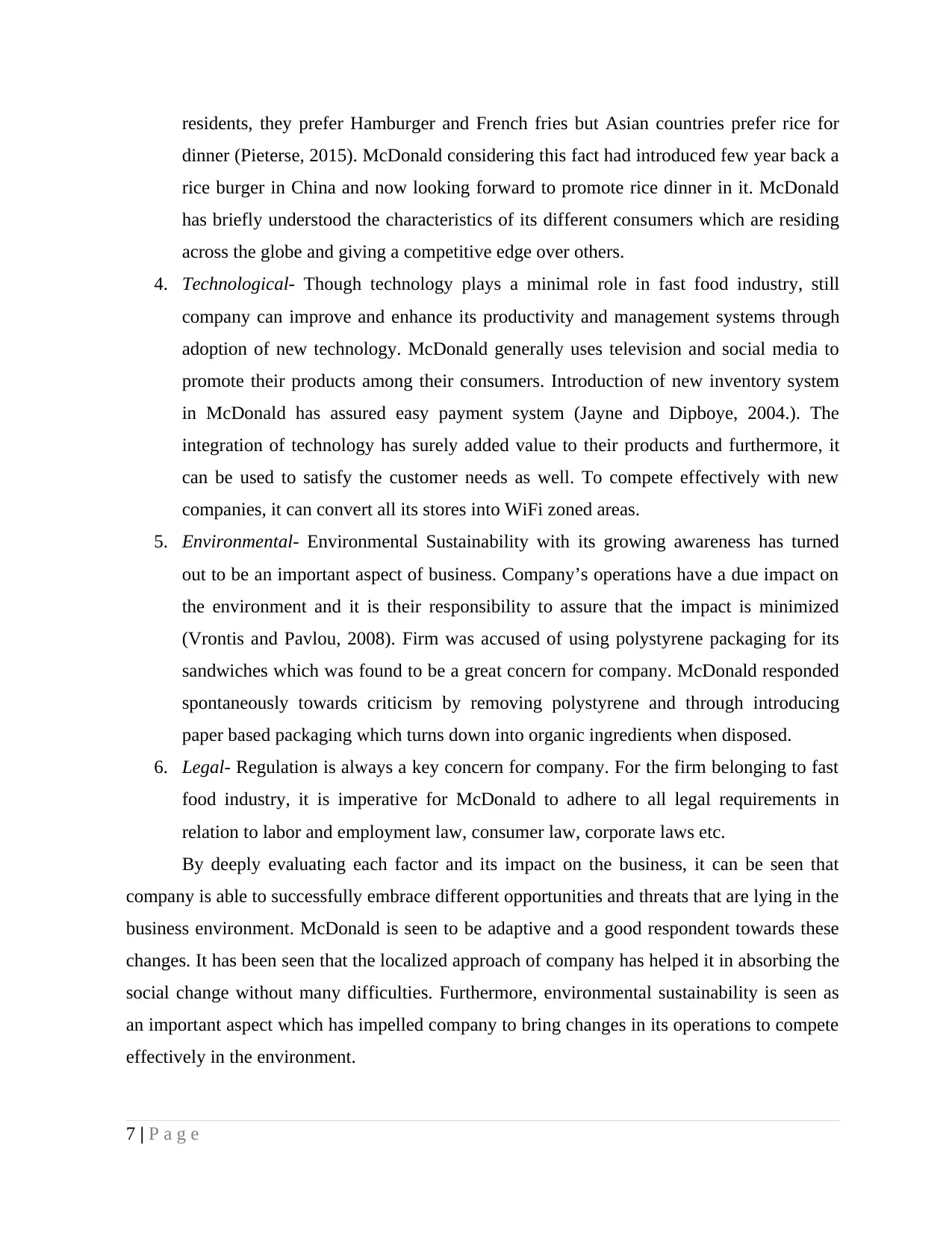
residents, they prefer Hamburger and French fries but Asian countries prefer rice for
dinner (Pieterse, 2015). McDonald considering this fact had introduced few year back a
rice burger in China and now looking forward to promote rice dinner in it. McDonald
has briefly understood the characteristics of its different consumers which are residing
across the globe and giving a competitive edge over others.
4. Technological- Though technology plays a minimal role in fast food industry, still
company can improve and enhance its productivity and management systems through
adoption of new technology. McDonald generally uses television and social media to
promote their products among their consumers. Introduction of new inventory system
in McDonald has assured easy payment system (Jayne and Dipboye, 2004.). The
integration of technology has surely added value to their products and furthermore, it
can be used to satisfy the customer needs as well. To compete effectively with new
companies, it can convert all its stores into WiFi zoned areas.
5. Environmental- Environmental Sustainability with its growing awareness has turned
out to be an important aspect of business. Company’s operations have a due impact on
the environment and it is their responsibility to assure that the impact is minimized
(Vrontis and Pavlou, 2008). Firm was accused of using polystyrene packaging for its
sandwiches which was found to be a great concern for company. McDonald responded
spontaneously towards criticism by removing polystyrene and through introducing
paper based packaging which turns down into organic ingredients when disposed.
6. Legal- Regulation is always a key concern for company. For the firm belonging to fast
food industry, it is imperative for McDonald to adhere to all legal requirements in
relation to labor and employment law, consumer law, corporate laws etc.
By deeply evaluating each factor and its impact on the business, it can be seen that
company is able to successfully embrace different opportunities and threats that are lying in the
business environment. McDonald is seen to be adaptive and a good respondent towards these
changes. It has been seen that the localized approach of company has helped it in absorbing the
social change without many difficulties. Furthermore, environmental sustainability is seen as
an important aspect which has impelled company to bring changes in its operations to compete
effectively in the environment.
7 | P a g e
dinner (Pieterse, 2015). McDonald considering this fact had introduced few year back a
rice burger in China and now looking forward to promote rice dinner in it. McDonald
has briefly understood the characteristics of its different consumers which are residing
across the globe and giving a competitive edge over others.
4. Technological- Though technology plays a minimal role in fast food industry, still
company can improve and enhance its productivity and management systems through
adoption of new technology. McDonald generally uses television and social media to
promote their products among their consumers. Introduction of new inventory system
in McDonald has assured easy payment system (Jayne and Dipboye, 2004.). The
integration of technology has surely added value to their products and furthermore, it
can be used to satisfy the customer needs as well. To compete effectively with new
companies, it can convert all its stores into WiFi zoned areas.
5. Environmental- Environmental Sustainability with its growing awareness has turned
out to be an important aspect of business. Company’s operations have a due impact on
the environment and it is their responsibility to assure that the impact is minimized
(Vrontis and Pavlou, 2008). Firm was accused of using polystyrene packaging for its
sandwiches which was found to be a great concern for company. McDonald responded
spontaneously towards criticism by removing polystyrene and through introducing
paper based packaging which turns down into organic ingredients when disposed.
6. Legal- Regulation is always a key concern for company. For the firm belonging to fast
food industry, it is imperative for McDonald to adhere to all legal requirements in
relation to labor and employment law, consumer law, corporate laws etc.
By deeply evaluating each factor and its impact on the business, it can be seen that
company is able to successfully embrace different opportunities and threats that are lying in the
business environment. McDonald is seen to be adaptive and a good respondent towards these
changes. It has been seen that the localized approach of company has helped it in absorbing the
social change without many difficulties. Furthermore, environmental sustainability is seen as
an important aspect which has impelled company to bring changes in its operations to compete
effectively in the environment.
7 | P a g e
Paraphrase This Document
Need a fresh take? Get an instant paraphrase of this document with our AI Paraphraser
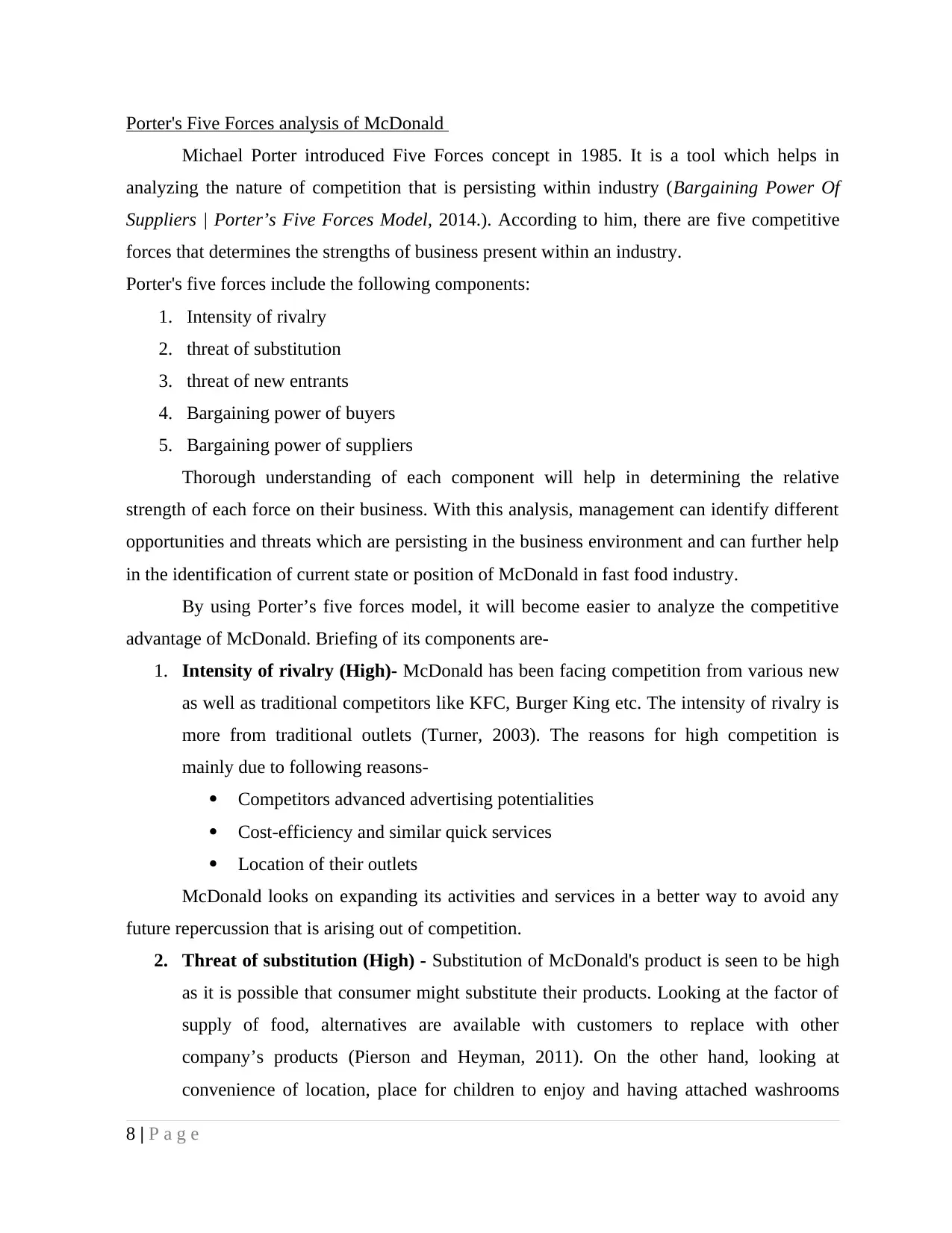
Porter's Five Forces analysis of McDonald
Michael Porter introduced Five Forces concept in 1985. It is a tool which helps in
analyzing the nature of competition that is persisting within industry (Bargaining Power Of
Suppliers | Porter’s Five Forces Model, 2014.). According to him, there are five competitive
forces that determines the strengths of business present within an industry.
Porter's five forces include the following components:
1. Intensity of rivalry
2. threat of substitution
3. threat of new entrants
4. Bargaining power of buyers
5. Bargaining power of suppliers
Thorough understanding of each component will help in determining the relative
strength of each force on their business. With this analysis, management can identify different
opportunities and threats which are persisting in the business environment and can further help
in the identification of current state or position of McDonald in fast food industry.
By using Porter’s five forces model, it will become easier to analyze the competitive
advantage of McDonald. Briefing of its components are-
1. Intensity of rivalry (High)- McDonald has been facing competition from various new
as well as traditional competitors like KFC, Burger King etc. The intensity of rivalry is
more from traditional outlets (Turner, 2003). The reasons for high competition is
mainly due to following reasons-
Competitors advanced advertising potentialities
Cost-efficiency and similar quick services
Location of their outlets
McDonald looks on expanding its activities and services in a better way to avoid any
future repercussion that is arising out of competition.
2. Threat of substitution (High) - Substitution of McDonald's product is seen to be high
as it is possible that consumer might substitute their products. Looking at the factor of
supply of food, alternatives are available with customers to replace with other
company’s products (Pierson and Heyman, 2011). On the other hand, looking at
convenience of location, place for children to enjoy and having attached washrooms
8 | P a g e
Michael Porter introduced Five Forces concept in 1985. It is a tool which helps in
analyzing the nature of competition that is persisting within industry (Bargaining Power Of
Suppliers | Porter’s Five Forces Model, 2014.). According to him, there are five competitive
forces that determines the strengths of business present within an industry.
Porter's five forces include the following components:
1. Intensity of rivalry
2. threat of substitution
3. threat of new entrants
4. Bargaining power of buyers
5. Bargaining power of suppliers
Thorough understanding of each component will help in determining the relative
strength of each force on their business. With this analysis, management can identify different
opportunities and threats which are persisting in the business environment and can further help
in the identification of current state or position of McDonald in fast food industry.
By using Porter’s five forces model, it will become easier to analyze the competitive
advantage of McDonald. Briefing of its components are-
1. Intensity of rivalry (High)- McDonald has been facing competition from various new
as well as traditional competitors like KFC, Burger King etc. The intensity of rivalry is
more from traditional outlets (Turner, 2003). The reasons for high competition is
mainly due to following reasons-
Competitors advanced advertising potentialities
Cost-efficiency and similar quick services
Location of their outlets
McDonald looks on expanding its activities and services in a better way to avoid any
future repercussion that is arising out of competition.
2. Threat of substitution (High) - Substitution of McDonald's product is seen to be high
as it is possible that consumer might substitute their products. Looking at the factor of
supply of food, alternatives are available with customers to replace with other
company’s products (Pierson and Heyman, 2011). On the other hand, looking at
convenience of location, place for children to enjoy and having attached washrooms
8 | P a g e
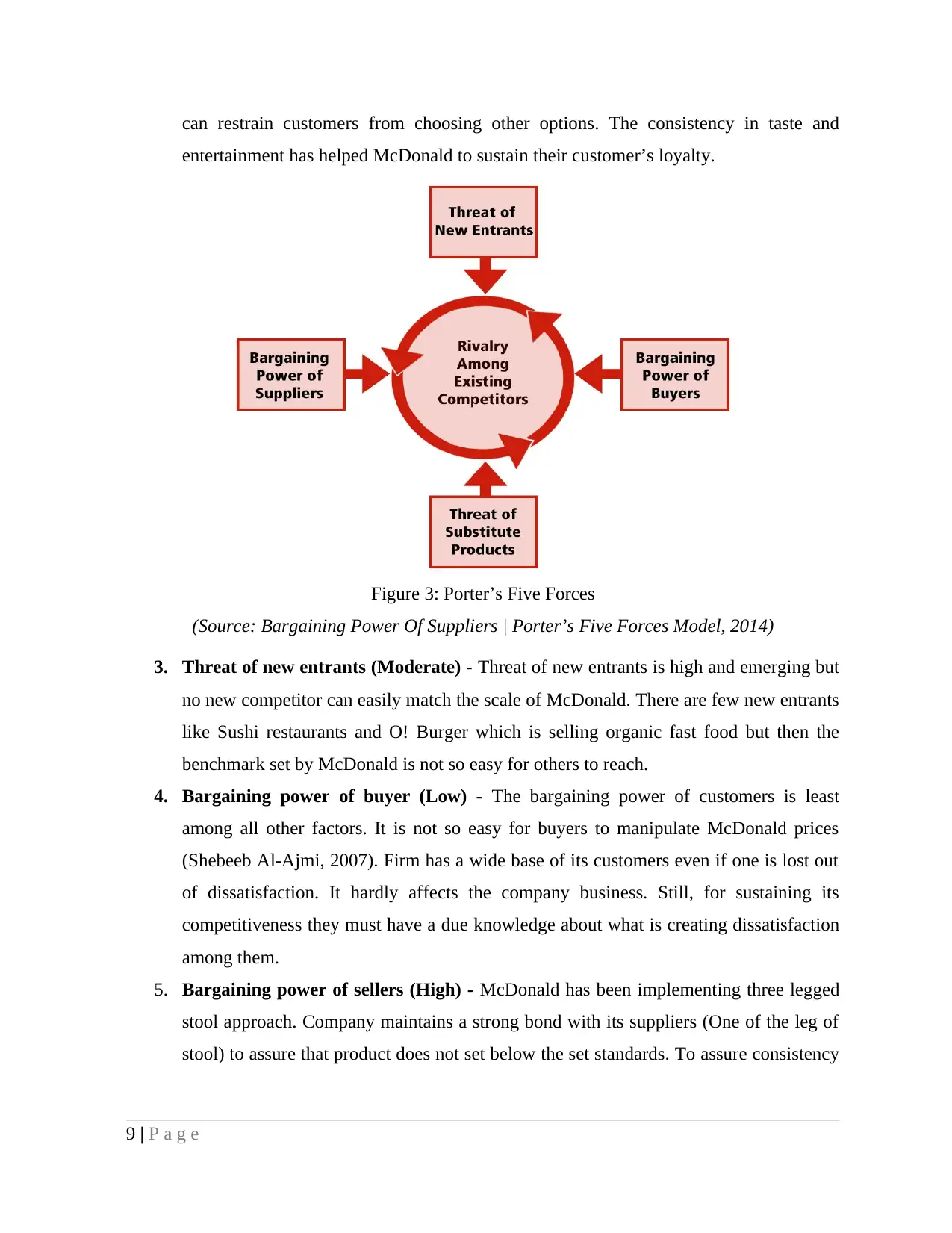
can restrain customers from choosing other options. The consistency in taste and
entertainment has helped McDonald to sustain their customer’s loyalty.
Figure 3: Porter’s Five Forces
(Source: Bargaining Power Of Suppliers | Porter’s Five Forces Model, 2014)
3. Threat of new entrants (Moderate) - Threat of new entrants is high and emerging but
no new competitor can easily match the scale of McDonald. There are few new entrants
like Sushi restaurants and O! Burger which is selling organic fast food but then the
benchmark set by McDonald is not so easy for others to reach.
4. Bargaining power of buyer (Low) - The bargaining power of customers is least
among all other factors. It is not so easy for buyers to manipulate McDonald prices
(Shebeeb Al-Ajmi, 2007). Firm has a wide base of its customers even if one is lost out
of dissatisfaction. It hardly affects the company business. Still, for sustaining its
competitiveness they must have a due knowledge about what is creating dissatisfaction
among them.
5. Bargaining power of sellers (High) - McDonald has been implementing three legged
stool approach. Company maintains a strong bond with its suppliers (One of the leg of
stool) to assure that product does not set below the set standards. To assure consistency
9 | P a g e
entertainment has helped McDonald to sustain their customer’s loyalty.
Figure 3: Porter’s Five Forces
(Source: Bargaining Power Of Suppliers | Porter’s Five Forces Model, 2014)
3. Threat of new entrants (Moderate) - Threat of new entrants is high and emerging but
no new competitor can easily match the scale of McDonald. There are few new entrants
like Sushi restaurants and O! Burger which is selling organic fast food but then the
benchmark set by McDonald is not so easy for others to reach.
4. Bargaining power of buyer (Low) - The bargaining power of customers is least
among all other factors. It is not so easy for buyers to manipulate McDonald prices
(Shebeeb Al-Ajmi, 2007). Firm has a wide base of its customers even if one is lost out
of dissatisfaction. It hardly affects the company business. Still, for sustaining its
competitiveness they must have a due knowledge about what is creating dissatisfaction
among them.
5. Bargaining power of sellers (High) - McDonald has been implementing three legged
stool approach. Company maintains a strong bond with its suppliers (One of the leg of
stool) to assure that product does not set below the set standards. To assure consistency
9 | P a g e
⊘ This is a preview!⊘
Do you want full access?
Subscribe today to unlock all pages.

Trusted by 1+ million students worldwide
1 out of 15
Related Documents
Your All-in-One AI-Powered Toolkit for Academic Success.
+13062052269
info@desklib.com
Available 24*7 on WhatsApp / Email
![[object Object]](/_next/static/media/star-bottom.7253800d.svg)
Unlock your academic potential
Copyright © 2020–2025 A2Z Services. All Rights Reserved. Developed and managed by ZUCOL.





